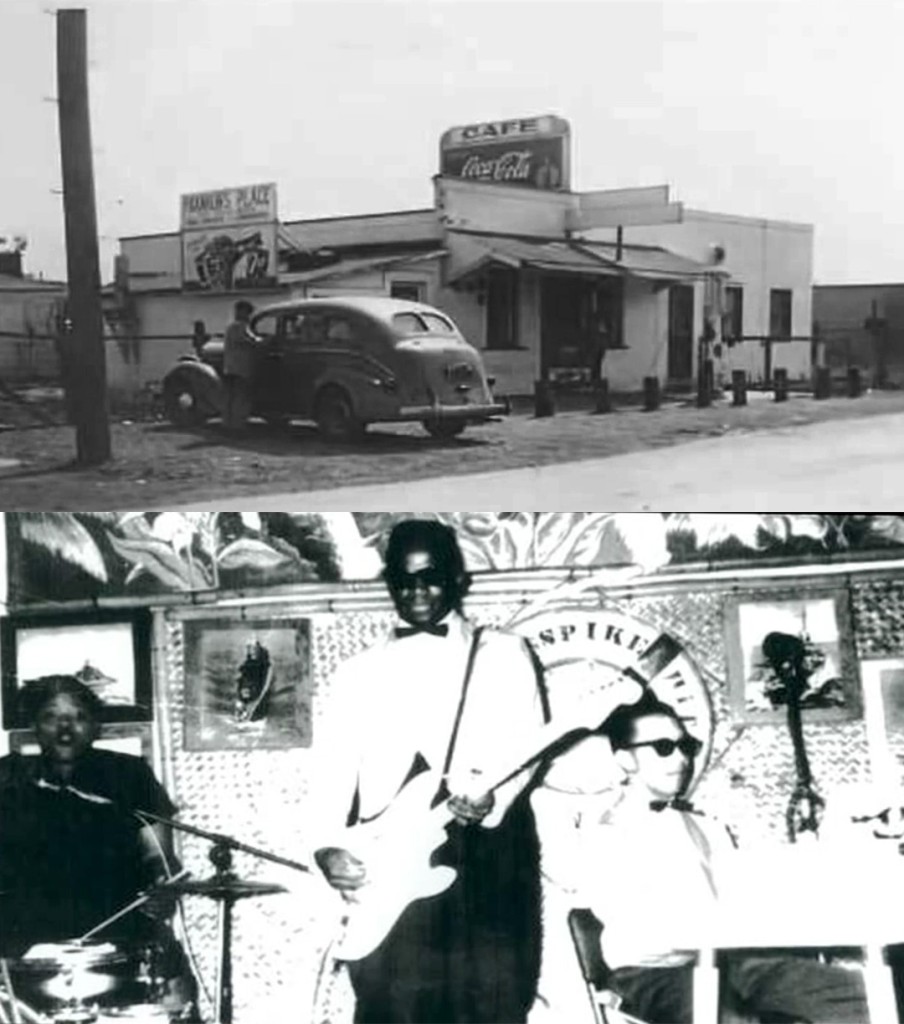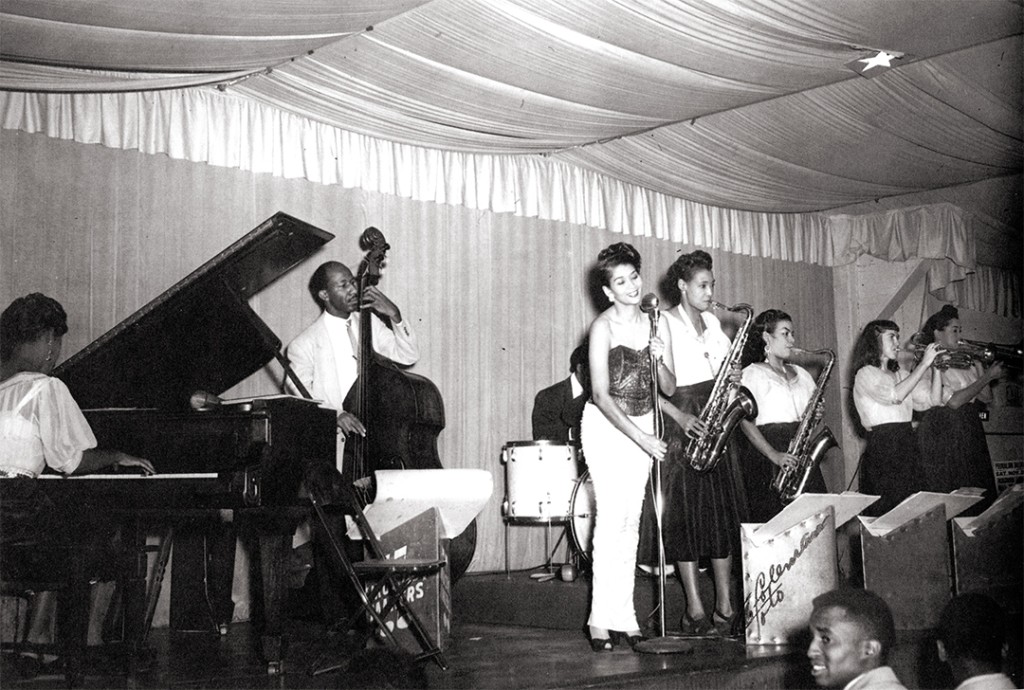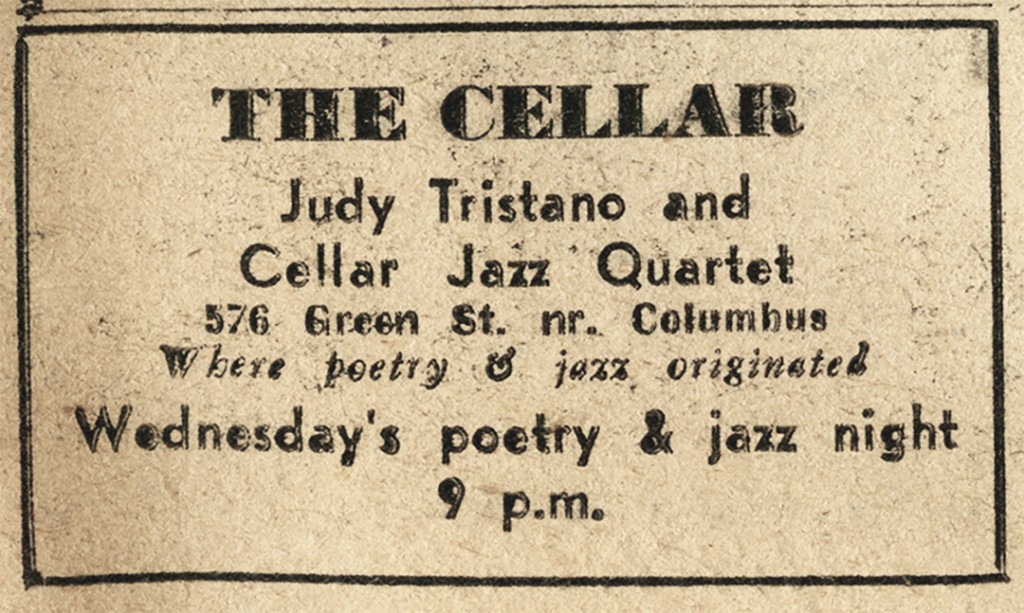West Coast Blues & Russell City; Fillmore venues; Sugar Pie DeSanto, Vince Guaraldi; Ralph J. Gleason & Jazz Casual TV

San Francisco was a crossroads for dynamic developments in Jazz and ethnic entertainment. A rich mid-century efflorescence of Jazz and Popular music emerged on diverging vectors of Dixieland, Modern and the Blues. Bebop and Rhythm & Blues thrived in The Fillmore district, aka “Harlem of the West.” Blues music flourished in Oakland and environs.
New artists and forms emerged, garnering world-renown in North Beach nightclubs and Tenderloin jazz bars or were seen on the innovative Jazz Casual educational television series produced by Ralph J. Gleason. As the 1950s became the’60s, San Franciscans increasingly downplayed their boomtown Barbary Coast origins, as echoed in the oft-repeated local admonition, “don’t call it Frisco.”

Oakland and the West Coast Blues
Oakland and the East Bay were crossroads for the Blues offering an abundance of talent, venues, impresarios and recording studios. West Coast Blues is generally defined as being jazz-influenced, with jazzy guitar solos and strong piano, often featuring smooth, honey-toned vocals crossing over into R&B. Many of its progenitors were Texas musicians transplanted to California, though numerous proponents of the style settled in Chicago, such as T-Bone Walker, or in Los Angeles like Charles Brown.
Bob Geddins (1913-1991) was an independent East Bay Blues and R&B impresario, song composer and A&R man who produced numerous records. His keenest competitor was Jimmy McCracklin (1921-2012), a powerhouse musician, bandleader, singer, songwriter and record producer who also owned a San Francisco nightclub.

Russell City Blues
A lively music scene and jumping nightlife flourished in the area known as Russell City south of Oakland near Hayward. It was named for Frederick James Russell who laid out the town plan in 1907, but it had begun earlier as a bucolic agricultural hamlet. WWII brought rapid growth and an influx of African Americans mostly from the South working in Bay Area shipyards. But Alameda County government refused pleas for town incorporation or annexation.
Numerous tiny music venues originated much like the early juke joints of the South where folks gathered to dance on dirt floors or under tin roofs. Today, Russell City is thought to have been a significant focal point in the development of the West Coast Blues where singers Big Mama Thornton, Muddy Waters, Lowell Fulson and Sugar Pie DeSanto were popular attractions.
Notables of Russell City
Texas native Juke Boy Bonner (1932-1978) accompanied himself on guitar, harmonica and drums, releasing a few singles in the mid-1950s to mixed success. After 1967 he enjoyed modest renewed popularity thanks to local record labels and posthumous albums issued after his passing.
Pee Wee Crayton (1914-1985) migrated to California from Texas around 1935 before he became a singer and guitarist known for his smooth vocals and aggressive guitar. Crayton was very popular in Los Angeles and across the country. His song “Blues After Hours” reached #1 on the Billboard R&B chart in 1948. He was inducted to the Blues Hall of Fame in 2019.
Fillmore Slim (Clarence Sims, b. 1934) is a blues singer, harmonica player, guitarist and pimp who has been called “The Pope of Pimping.” During the 1970s he quit professional music and went into pimping full-time. He claims to have made millions while being chauffeured around in his Cadillac limousine pimpmobile running as many as twenty girls.
He resumed performing in the 1980s, becoming a celebrity, opening for B.B. King, singing about the pimping life and cutting albums as late as 2011. Garnering numerous awards, Fillmore Slim is in the West Coast Blues Hall of Fame and profiled in the 1999 Hughes Brothers’ film, “American Pimp.”

Curtailing Russell City
In the early-1960s Alameda County moved to dissolve Russell City and by 1966 most of the 12-blocks had been torn down or destroyed by arson. One of the last inhabitants to depart was Ernesto “Sam” Nava, the son of Mexican revolutionary leader Poncho Villa. Fourteen hundred residents were dispersed at the behest of powerful political and economic interests; the land was annexed and cleared for an industrial park.
This was not unlike numerous other destructive “redevelopment” projects across the USA which disrupted ethnic or marginalized communities — The Fillmore for instance. Recently, both the City of Hayward and Alameda County have issued formal apologies to the former occupants of Russell City.

Premier Venues of The Fillmore
Shifting demographics of the Fillmore district, known as “Harlem of the West,” are reflected in the evolution of four key venues: New Orleans Swing House, California Theater Club Restaurant, Primalon Ballroom, and The Fillmore Auditorium.

Fillmore Auditorium, 1912-today:
Built in 1912, The Fillmore Auditorium was (and is) among the more famous entertainment facilities of San Francisco. It has served many functions:
- 1912-28: Majestic Hall and Academy of Dancing, run by female proprietors.
- 1928-36: Majestic Ballroom under new management.
- 1936-52: Ambassador Dance Hall or Majestic Roller Rink; after 1949 name bands played for dances on the weekends.
- 1954-64: Reopened as the very successful Fillmore Auditorium with 95% Black attendance for shows by James Brown, Gladys Knight, Bobby “Blue” Bland and B.B. King.
- 1965-71: Bill Graham Rock music era.
- 1970s: Black Muslim Temple.
- 1980s: The Elite Club, purveying punk rock.
- 1986-current: Reopened as New Fillmore Auditorium.
California Theater Club Restaurant, 1940-61:

This location began as a neighborhood Japanese American establishment, “Cherryland Sukiyaki Club.” After the forced relocation of Japanese Americans in 1942 it became a noteworthy African American establishment, California Theater Club Restaurant.
It’s described in the definitive book Harlem of the West, by Elizabeth Pepin and Lewis Watts (Chronicle Books, 2006) as offering “elaborate entertainment including a chorus line of dancing girls. And famous name bands . . . just like a Hollywood Club, with Sepia Floorshows nightly.” By around 1946 it was offering top name orchestras, “like a Hollywood club” recalled local bandleader Johnnie Ingram:
They had nightly shows. The waitresses were all in uniform and you couldn’t have found a better place if you had gone to New York. My band played there, Jack Porter’s band out of Los Angeles played there, Jack McVea also came up from LA and played there. The California Theater Restaurant was the place at the time.
From 1947 to 1953 the marquee was Gourmet Theater Restaurant. It returned to Asian American ownership in 1953 as Tokyo Parlor Restaurant until it was closed, and the building demolished in 1961.
Primalon Ballroom, 1934-61:
The large indoor/outdoor entertainment facility located at 1223 Fillmore Street was a community focal point that first opened in 1934 as the Woodland Dancing Hall with miniature golf links. After WWII it was the Brown Bomber Café, a beer garden offering roller skating on weekdays with simultaneous skating and dancing under the suspended mirror balls on the weekends.

Becoming Primalon Ballroom in 1949, top acts were on offer including Count Basie, Lionel Hampton, Dizzy Gillespie and local blues bands like Pee Wee Crayton. Besides serving as a dance hall it was a multi-purpose recreational facility. Drummer Earl Watkins recalls that at some point the Young Communist League took over management, abolishing the segregationist policy and running it as a multi-ethnic community center. Closing in 1961, the structure was torn down in 1974.
New Orleans Swing House/Champagne Supper Club, 1942-57:

The New Orleans Swing House (aka New Orleans Swing Club) was a notable Black-owned nightclub. It began by catering to newly arriving Black shipyard workers from the South hankering for Louisiana music and Southern cooking. The original owner was New Orleans-native Louis Landry who built it from scratch.
Aspiring to the opulence of the original Cotton Club in Harlem, performers included Louis Armstrong, Kid Ory, Jack Teagarden, Count Basie, Earl “Fatha” Hines, Buddy DeFranco, Jerome Richardson, Saunders King and Nick Esposito. But Landry got into trouble with the IRS around 1951.
It reopened as the Champagne Supper Club in 1952. Managed by Curtis Mosby, a former bandleader and successful LA and Frisco nightclub operator, it was the first marquee in The Fillmore where Billie Holiday sang.
“Miss Sugar Pie” DeSanto

Filipina American singer “Sugar Pie” DeSanto (Upeylia Marsmea Bainton, b. 1935) was raised in and emerged from The Fillmore district. Standing less than five feet tall, she was a vivacious R&B performer who sang while gyrating and contorting, dancing sexy go-go style barefoot on stage. She opened at the “The Apollo Theater” for James Brown numerous times and on his 1959-60 tours.
DeSanto was a lifelong friend and associate of singer Etta James (Jamesetta Hawkins, 1938-2012) who also emerged from the Fillmore. They performed duets and recorded hits produced by Bob Geddins, often backed by the band of DeSantos’ ex-husband Pee Wee Kingsley.
A prolific songwriter, her original “I Want to Know” backed by Kingsley reached #4 on the Billboard Hot R&B list. The duo of Sugar Pie and Etta James made chart-topping hits for Chess Records in 1965-66. “Do I Make Myself Clear?” and “In the Basement” were both written by DeSanto who published another 100 songs.
Recipient of numerous awards, “Sugar Pie” DeSanto remains active today. Her official website says she is “far more than a great Blues singer, she’s also a first-class soul singer, a commanding jazz stylist, an uproarious comedienne and an expert tunesmith.”
The Prince of Guaraldi
Vince Guaraldi (Vincent Anthony Dellaglio; b. San Francisco, CA 1928, d. Menlo Park, CA 1976) was very popular in Northern California long before his affiliation with the “Charlie Brown” television shows for which he’s best-known. Born and raised in the North Beach district he showed early interest in the piano and was inspired by two maternal uncles who ran big bands.
Guaraldi served several early stints in various jazz combos, orchestras and bands: Georgie Auld (1953), Woody Herman (1956-59), Conti Condoli (1957, 1960) and with vibraphonist Cal Tjader at the “Blackhawk” in the Tenderloin (1957-59). His solo career was nurtured in the intimate coffee house atmosphere of “The Hungry i” nightclub.
In the early 1960s Guaraldi paired up with Brazilian guitarist Bola Sete. Their cool, bossa nova sound met with popular and critical acclaim and they toured widely. Possessing a natural aptitude for melody, the popular pianist created a distinctive keyboard touch utilizing his palm in creating a fresh jazz vocabulary.
In 1962, his original tune “Cast Your Fate to the Wind” was a huge hit on the Top 100 charts for 19 weeks. Winning a Grammy, it opened huge opportunities and led to his selection for the Charles Schulz cartoon television specials.
Pivoting to commercial popularity allowed him to buy a home North of San Francisco in woodsy Mill Valley. For a long time, he remained married to his high school sweetheart (and mother of their two children) though publicly kept a mistress.
Vast success brought fresh opportunities. Driven and single-minded, he recorded for a dozen record companies, pushing himself to the limit. Seeking to get in sync with contemporary Rock music he delved into Funk and Soul genres. Switching to electric keyboard, he experimented with early Moog-type synthesizers.
The location of his passing in February 1976 at age forty-seven is usually cited as Menlo Park because he died in a hospital there from a heart attack after a gig. While Vince Guaraldi remained primarily in the jazz combo format, he became forever linked with the Charles Schulz/Charlie Brown TV cartoon specials that made him an icon of mid-century American Popular culture.

Ralph J. Gleason: Music Journalist & Media Impresario
Ralph J. Gleason was born in New York City 1917 and died of a heart attack at his Berkeley home in 1975. He successful transitioned from music journalist to an influential critic and music arbitrager, television producer and impresario.
The unabridged New Grove Dictionary of Jazz (St. Martin’s Press, 1988) neatly sums up his many achievements:
After studying at Columbia University (1934-38) he became a founder and served (from 1939 to 1941) as the editor of Jazz Information, one of the first jazz periodicals in the USA . . . He was associated from 1948 to 1961 with Down Beat and from 1950 until his death with the San Francisco Chronicle, to which he contributed columns and criticism on jazz and popular music.
In 1958, with Jimmy Lyons, he founded the Monterey Jazz Festival. He was a host of jazz radio programs in San Francisco in the 1960s and of the television series “Jazz Casual” (for National Educational Television), which he also produced. In 1970 he became a vice president of the record company Fantasy.

He wrote a syndicated weekly column on jazz (1957-70) and contributed to many periodicals . . . Gleason was among the first writers of jazz to take an interest in rock music, and in 1970 he was a founder of Rolling Stone, for which during the following years he also worked as an editor and columnist.
The Jazz Casual television series was Gleason’s brainchild. He presented a broad spectrum of talented musicians in an innovative studio-performance-with-interview format produced at KQED-TV in San Francisco for National Educational Television (NET) between 1961-68. He benefitted from access to the wide range of local stars and major talent passing through town, presenting Dizzy Gillespie, Count Basie, Sonny Rollins, Modern Jazz Quartet, Dave Brubeck, Carmen McRae, B.B. King, Turk Murphy, Gerry Mulligan, John Coltrane, Charles Lloyd, Jimmy Rushing and big bands run by Woody Herman, Thad Jones and Mel Lewis.

Mid-century Bagdad-by-the-Bay
Oakland, the East Bay and Russell City were a nexus for R&B and the Blues. Emerging Bebop revolutionaries found a home in The Fillmore. The region was an incubator for all kinds of music. But the era described above ended on the eve of the 1967 “Summer of Love” in San Francisco.
College-age students who had been steady patrons of the smaller nightspots during the mid-1960s switched allegiances from Folk, Dixieland and the Blues to Rock music — and nowhere more decisively. Meanwhile in North Beach topless entertainment drove out classy nightclubs and the Jazz dives.
From the 1940s through the ‘60’s, local talent and adopted musicians emerged as eminent San Francisco artists. While a remnant of boomtown Frisco entertainment persisted for tourists, newly expressive forms of Jazz and Popular music were maturing shaped by the distinctive history, Western outlook and individualistic culture of greater Bagdad-by-the-Bay.
Bibliography:
Harlem of the West: The San Francisco Fillmore Jazz Era, Elizabeth Pepin Silva & Lewis Watts (Chronicle Books, 2006/Heyday, 2020)
Russell City, Maria Ochoa & the Hayward Area Historical Society (Arcadia Publishers, 2009)
San Francisco Jazz, Medea Isphording Bern (Arcadia Publishing, 2014)
Media & YouTube links:
Buying In: The Music of Vince Guaraldi (student film)
https://youtu.be/CRTMuLJP4SA?si=3yUKrhSCqajR1Bl6
Vince Guaraldi, Ben Webster & Jimmy Witherspoon on Jazz Casual
https://youtu.be/j6R-mKBYOeg?si=BrtzhwtaMSCnjIcv
Joe Sullivan on Jazz Casual
https://youtu.be/ZI0Pg5kMBp8?si=2Any58GgBNgAEIfK
Count Basie on Jazz Casual
https://youtu.be/Ke3W5DQ6U1U?si=KaimVFKNpxHXOKz8
Cannonball Adderley on Jazz Casual
https://youtu.be/tg-e_SX0nKg?si=1Na37q9GHbEYWzg3
Jazz Casual Channel
Russell City
https://www.ktvu.com/news/west-coast-blues-flourished-in-long-gone-russell-city-west-of-hayward
https://www.nbcnews.com/news/nbcblk/fight-reparations-hayward-californias-russell-city-rcna88899
https://www.ktvu.com/news/west-coast-blues-flourished-in-long-gone-russell-city-west-of-hayward
https://youtu.be/svus7tc8mTc?si=FlW3ycykhzbaWAeO
https://youtu.be/svus7tc8mTc?si=M5d9MJAnNGjjzfdU
https://youtu.be/8pZKYxmxlak?si=XsVq5UjHE4NVprVN
https://youtu.be/8pZKYxmxlak?si=otgo7o53FC8Clp7W
https://youtu.be/K8f9ZSNonIc?si=lK_mR3UuTlndhpUz
Ralph J. Gleason
https://greilmarcus.net/2014/07/21/ralph-j-gleason-1917-1975/
https://www.npr.org/2016/05/23/478884245/from-duke-to-the-dead-ralph-j-gleason-loved-it-all

Dave Radlauer is a six-time award-winning radio broadcaster presenting early Jazz since 1982. His vast JAZZ RHYTHM website is a compendium of early jazz history and photos with some 500 hours of exclusive music, broadcasts, interviews and audio rarities.
Radlauer is focused on telling the story of San Francisco Bay Area Revival Jazz. Preserving the memory of local legends, he is compiling, digitizing, interpreting and publishing their personal libraries of music, images, papers and ephemera to be conserved in the Dave Radlauer Jazz Collection at the Stanford University Library archives.





